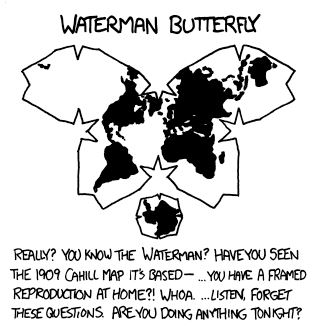Areas south of the Antarctic Circle experience extreme day-night cycles near the times of the June and December solstices, making it difficult to determine which time zone would be most appropriate. For practical purposes time zones are usually based on territorial claims; however, the time zone of their supply base is often utilised (e.g., McMurdo Station and Amundsen–Scott South Pole Station use New Zealand time due to their main supply base being Christchurch, New Zealand). In most areas south of 80 degrees latitude, Coordinated Universal Time (UTC) is assumed despite the limited presence of clocks.
It looks like a beachball. Must be warm and sandy there. /s
It is once you climb over the giant ice wall hiding the flat earth.
They made a flat one too?
If you speed up footage of the Earth’s rotation shot at this angle, you get the Mac spinning beach ball of doom
Why is the area around the south pole striped? The stripes aren’t in the map legend.
It’s not striped. Those are alternating regions of UTC+12 and UTC+13.
Yes, it’s excruciatingly annoying to try to get an accurate ETA when traveling through there. The research labs in that area regularly have to throw out samples because they walk them across the lab and all of the sudden they’re an hour too old.
wtf
They’re pulling your leg. I think it’s supposed to represent daylight savings time (that region is New Zealand’s bit, and it does use DST), but I’m not sure because Norway and Australia’s areas should also be striped if that’s the case
It’s Daylight Saving Times, as that area is McMurdo and the Amundsen-Scott South Pole Station. It sounds stupid to use DST in Antarctica, where half year is mostly darkness, half year is bright, they just simply use the time zone of the supporting country, here it’s New Zealand
The Norwegian section also uses DST, but it’s not official, hence it’s not on this map:
The time zone where Troll is located, UTC+0, is 1 hours behind Norwegian time". Contacts with the Norwegian Polar Institute has revealed that they use UTC+2 (Norwegian DST) during the dark winter, for communication simplicity, since no airplanes fly anyway then)
they should have their own timezone
What do you imagine this to be? One toggling between “always noon” and “don’t care, dark anyways”?
one for when its cold


